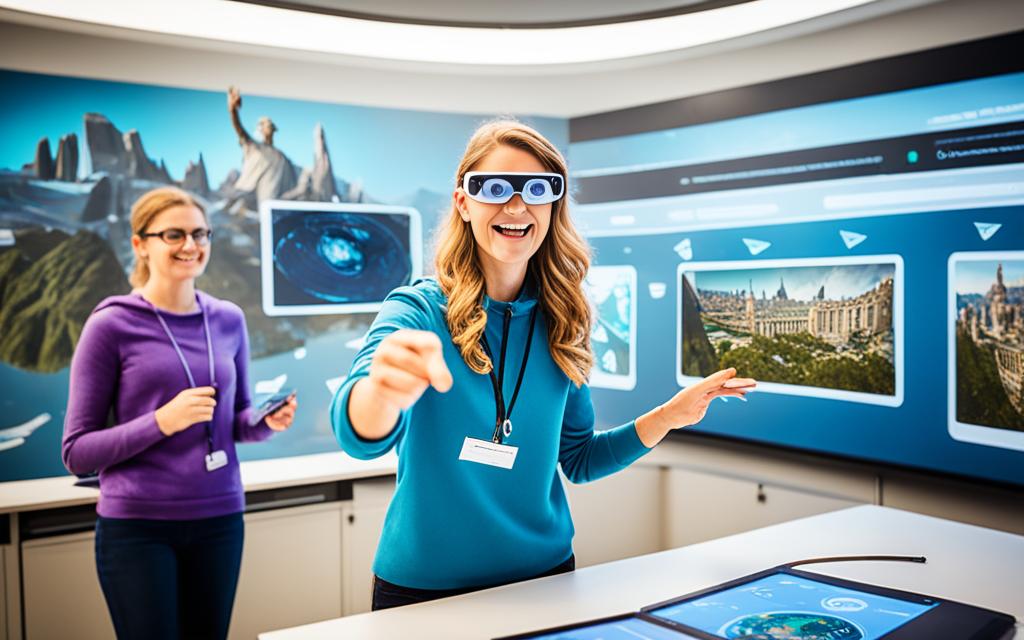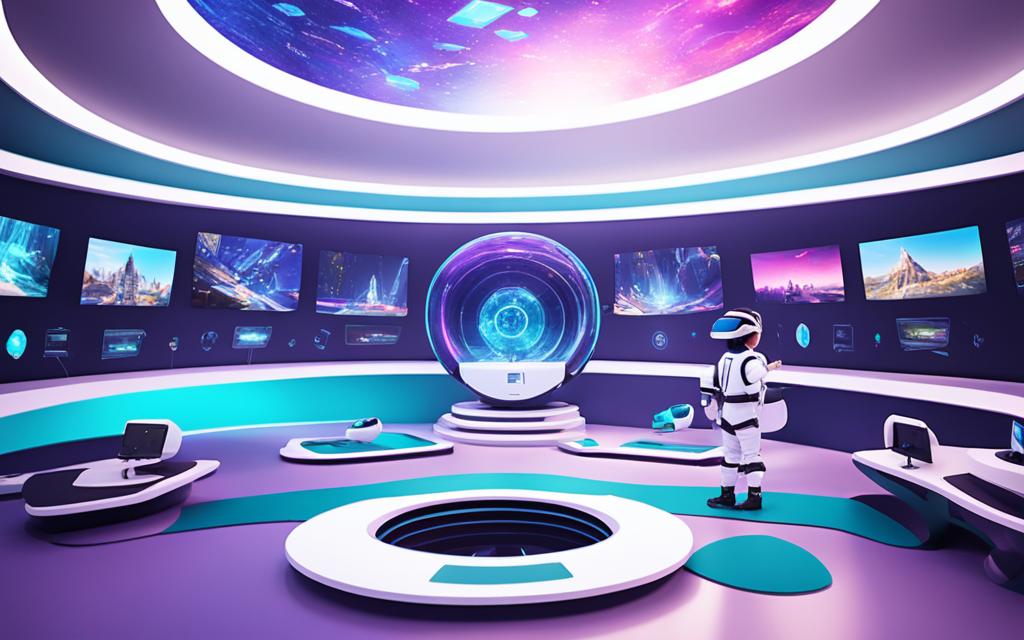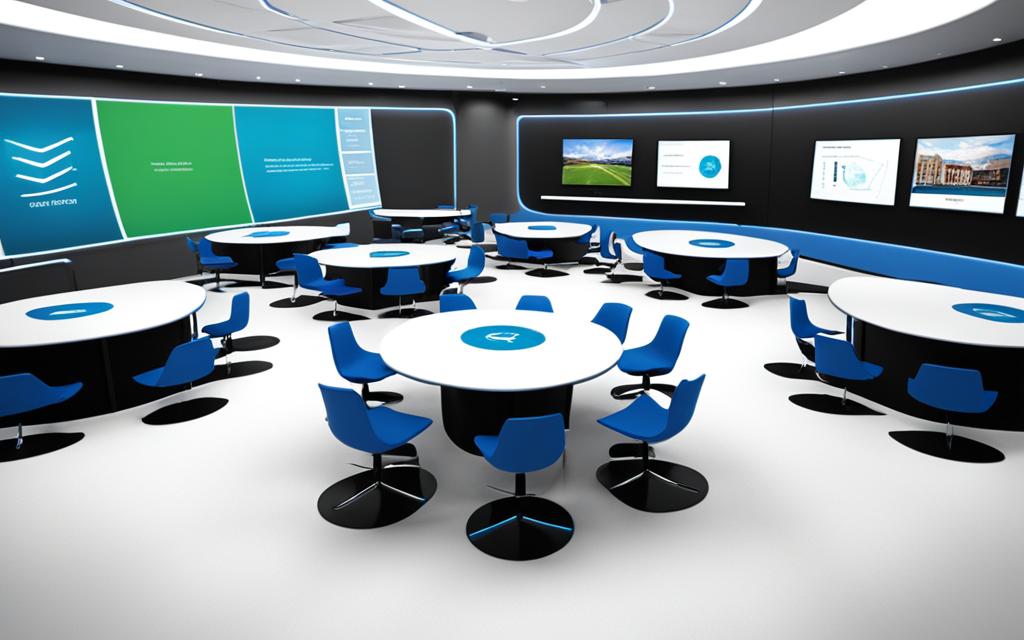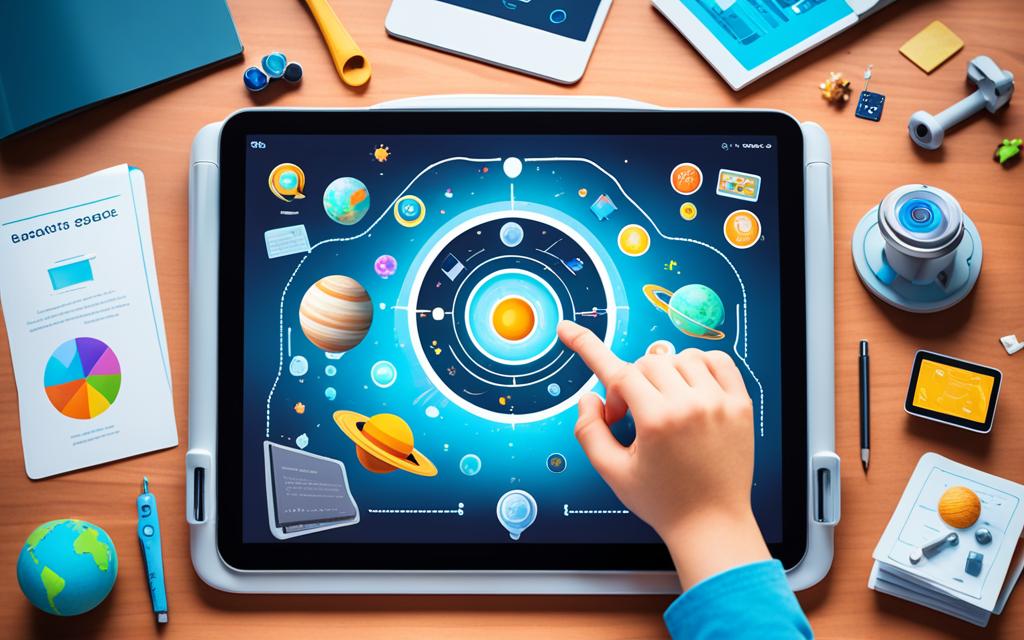In today’s educational scene, top-notch technology is changing everything. It’s making learning different for students and teaching easier for teachers. We’ll look at the latest tech in education, like virtual reality (VR), augmented reality (AR), gamification, and AI analytics. These tools are reshaping how we approach learning.1
Virtual reality lessons let students practice what they learn in real-life scenarios. For example, they might handle a virtual air traffic control situation during math class.1 Augmented reality turns museum displays and science books into exciting, hands-on experiences. It’s a fun new way for students to learn.1 AI-driven tools adapt the learning process to each student’s unique needs. This ensures everyone has a personalized, enriching learning path.
The metaverse, a digital space for shared learning, is having a big impact too. It includes virtual classrooms and campuses that replicate real environments. The goal is to spark curiosity and find new, engaging ways to learn.1 This article also looks at models like SAMR. These models help teachers use new technology effectively, guiding student growth and success.
Key Takeaways
- Immersive VR and AR experiences are revolutionizing the learning process, making it more engaging and interactive.
- Adaptive learning systems powered by AI can personalize the curriculum to individual student needs, enhancing the educational journey.
- The metaverse is transforming education, enabling collaborative virtual classrooms and digital twin campuses.
- Technology integration models like SAMR can guide educators in effectively incorporating digital tools into their teaching practices.
- Cutting-edge education technologies are nurturing student curiosity and fostering new modes of engagement.
Immersive Learning Experiences Through Virtual Reality
Virtual reality is changing education. It makes learning fun and engaging. Students experience lessons in a whole new way.
A company named Prisms VR is leading this change. Their VR lessons let students enter realistic worlds. For instance, in math, they might control virtual planes. This helps them see math in a real-life situation.2
Virtual Field Trips and Simulations
With VR, schools can take field trips without leaving the classroom. For instance, students can visit museums. This way, they can see and interact with exhibits virtually. It makes learning more interesting and fun.2
Gamified Learning Environments
VR also turns learning into games. This approach is called gamification. It adds fun challenges and rewards to lessons. This makes school feel like a game. And students learn better because of it.2
Studies support that VR helps students learn better. It boosts understanding, memory, and the desire to learn. Research results are positive in many areas.23
Augmented Reality in the Classroom
Augmented reality, or AR, is changing how lessons are taught. It makes learning fun and interactive.4 In schools, teachers use AR to make topics like science and history come alive. They do this by turning normal books into exciting adventures. They can also show hard ideas like math in 3D to help students really get it.4
Interactive Museum Exhibits
Imagine being able to touch things in a museum without actually being there. AR apps can do that.4 They change how we learn by letting us see and touch very old, important objects. This makes learning much more interesting and easy to remember.4
3D Anatomy and Science Models
AR also makes studying science incredibly cool. It creates 3D models of body parts, tiny things, and big scientific ideas.45 This really helps students learn in a way that feels like playing. This works great for science and math classes, making them a lot more fun and interesting. It’s also good for the environment. Virtual things can be added to the real world, making learning easier and more student-focused.5

Innovations in Education Technology
The education world is changing fast, thanks to new innovations in education technology. Now, students all around the world are learning in exciting ways. From virtual reality (VR) and artificial intelligence (AI) to cloud computing and 3D printing, the latest tech is making learning better.
Big tech companies like Google, Sony, Oculus, and Samsung are big on VR for education. They’re making lessons more real, so students can practice what they learn in life-like ways.6 Plus, AI helps with grading, gives feedback, and personalizes learning for every student, even those who need extra attention.6
But the tech wave is not just about VR and AI. Cloud computing lets students access lessons and submit work from anywhere. And 3D printing makes complex lessons hands-on, especially in college.6
Schools are even using social media to connect students and share ideas. And new biometric systems, like face and eye recognition, help with security and tracking resources.6
Thanks to the Internet and gadgets like laptops and tablets, tech in education is growing fast. This has sparked a competition among tech and education companies.6 So, students can look forward to more exciting ways to learn.6
The Metaverse and its Impact on Education
The metaverse is growing and will change education. It’s a vast, connected digital world7 that will offer many chances to make learning better for everyone.
Virtual Reality for Immersive Learning
The metaverse will revolutionize education through virtual reality (VR). With VR, students can go to amazing places and be fully part of the lesson.8 Teaching using VR is over 10% better than regular ways, studies have shown.8 At Morehouse College, they use VR for three classes. Students gather on a virtual campus for their lessons.8 This deep level of involvement can make learning fun, help students understand and remember more, and make tough topics easier and more interesting.
Augmented Reality for Enhanced Experiences
In addition to VR, the metaverse uses augmented reality (AR) to make real-world classrooms better. With AR, students see digital things mixed into their real world.7 They can do things like explore a museum or study a 3D model. AR makes learning come alive in new and exciting ways.
Mixed Reality for Blended Environments
Mixed reality (MR) is another step, mixing virtual and real elements. It makes learning even more immersive and interesting7. The Metaverse offers real-time, interactive experiences that focus on working together and using all the senses7. MR helps create a shared space that makes it easy for teachers and students to work and learn together.

The metaverse mixing with VR, AR, and MR is very exciting for education. It will make learning more immersive, interactive, and personal. This will change how we teach and learn, bringing everyone closer through digital learning.
Personalized and Adaptive Learning
In education technology, we’re seeing big changes. Personalized and adaptive learning have changed how students learn. With AI and ML, tools now adapt lesson plans to fit each student’s needs.9
AI-Powered Curriculum Customization
These systems use smart algorithms. They check lots of data on how students do and interact.10 This info helps create special learning paths for each student. They get exercises and feedback that’s just right for them. This makes learning more centered on what each student is good at and how they learn.9
Language Learning with Real-Time Feedback
VR, AR and AI tools are making learning languages exciting and effective.9 Students get feedback right away and lessons that fit them. Learning goes faster and better.10 Straive, known for great learning tools, uses its know-how to make amazing language lessons. These tools really get students involved and feeling confident.10
By using personalized and adaptive learning, teachers can make classrooms that work for everyone.9 New tech is helping us imagine a world where all students succeed. It’s an exciting time in education, and it’s all about helping each student do their best.10
Virtual Classrooms and Remote Learning
With the metaverse, we’re seeing a big change in how we learn remotely. Now, where you live won’t limit where or when you learn. This shift is making learning more interactive and engaging than just video calls alone.
Collaborative Virtual Spaces for Teachers and Students
In these new online worlds, teachers and students meet not as themselves but as avatars. It’s a fresh, more hands-on way to learn that’s brought by AI and VR. These technologies are helping to make learning fun, personalized, and not so far from what it’s like in a real classroom.11
Digital Twin Campuses and Metaversities
Now, we’re even creating digital versions of university campuses – “metaversities.” These online campuses open new doors for learning and making friends from all over the world. Students can study, chat, and work together like in real life, mixing both worlds for a rich educational experience.12

But, setting all this up takes a lot of work. We need to make sure everything runs smoothly and that both teachers and students are ready to use these new tools. While it might be a challenge at first, the benefits are so exciting. Online classrooms and metaversities can change education for the better, making it more available and connected globally.12 The metaverse is really redefining how we learn, making it more personal and interactive than ever.
Technology Integration Models
Teachers are finding their way through new technology integration models. The SAMR model is key. It helps them see how well they’re using tech in class.13 The SAMR model shows four stages. These go from simple substitution to the big change of redefinition in learning. It’s been introduced in many studies.
The SAMR Model for Evaluating Technology Usage
The SAMR model gives teachers a clear path to check tech use in lessons.13 At the start, substitution just swaps paper for screen. But moving up, augmentation then modification really changes how learning happens. At the top, redefinition brings in new things tech makes possible.
Substitution, Augmentation, Modification, and Redefinition
Knowing SAMR helps teachers wisely pick technology integration models. Then they can plan lessons that use tech’s full power for better learning.13 The SAMR model is also used for checking how well tech sits in a classroom. It offers tips for its best use too.13
The SAMR model isn’t just for regular times. It’s used in different situations, like the COVID-19 pandemic.13 It looks into how the setting affects how teachers use tech to teach.
With the SAMR framework, teachers can wisely use tech. This can boost how well students learn and stay interested.
Nurturing Curiosity with Educational Technology
Today, new technologies are changing how we educate. They play a big part in sparking students’ curiosity. This encourages them to learn more about the world around them.14 Mixing modern STEM methods with the proven Montessori teachings creates exciting learning spaces. These places help students become more independent. They also boost creativity and dive deep into science.14
Engaging Resources and Real-World Connections
Using educational technology brings a ton of cool learning tools into students’ hands. These tools bridge what they learn in class with the real world.14 Trying out hands-on experiments, like using playdough to understand electricity, or looking at themselves in different mirrors, gets kids wondering. It makes them think, predict, and test their own ideas.14 Such student engagement not only helps them grasp scientific ideas better. It also builds up their critical thinking and problem-solving skills, which they’ll need later on.14
Virtual Field Trips and Partnerships
Educational technology doesn’t just enhance classroom time. It also opens up the world outside, giving students more ways to learn.15 Kids can go on virtual trips to museums and labs, meeting experts and seeing rare items, and they can do this from their classroom. This brings real-life connections closer to them in a way that was not possible before.15 Plus, unique educational partnerships, like a virtual trip with the NBA, show the behind-the-scenes of basketball. They help kids learn in exciting new ways that make them think outside the box.16
With virtual field trips and smart partnerships, educators can get their students really into all kinds of subjects. This makes them love learning more, going beyond the classroom walls.15 These high-tech projects allow students to push boundaries, ask interesting questions, and develop a real love for finding out new things.15

Support for Educators and Schools
Technology is changing how we learn fast. For teachers to use new tools well, they need our help.17 Teachers learn best in groups where they share what works and help each other.
Professional Learning Communities
Schools create spaces for teachers to get better together. In these friendly groups, teachers show their tricks and find new ways to use tech to help students.17 The goal is to hand them the keys to unlock the tech’s full power.
Embedded Educator Supports and Guides
Teachers also get help anytime they need with tools, guides, and ways to get better at teaching with tech.
This makes using tech easier and keeps teachers as up-to-date as possible, making learning an ongoing journey for all.17

Conclusion
The future of learning looks brighter than ever. Technology is changing the way we educate and learn. By using innovative tech like virtual reality and artificial intelligence, we’re making learning fun, interactive, and tailored to each student.
Imagine diving into a lesson through virtual or augmented reality. These tools allow students to learn in a hands-on way. They can experiment and practice real-world skills safely.18 Plus, adaptive learning makes sure every student can learn at their best pace. This personal touch helps each child excel.
Virtual classrooms and online learning are becoming more popular. They offer education to more people than ever before. Also, they teach students how to work in a digital world.19 As things change, our focus on tech, personalized learning, and immersive experiences will grow. These new ways of learning will support a future filled with motivated and capable learners.
FAQ
What are the latest innovations in education technology?
How is virtual reality transforming education?
What are the benefits of using augmented reality in the classroom?
How is the metaverse impacting education?
How is personalized and adaptive learning being enabled by technology?
What technology integration models can help educators effectively incorporate digital tools?
How can educational technology nurture student curiosity and exploration?
What support do educators need to effectively integrate educational technologies?
Source Links
- https://www.discoveryeducation.com/
- https://elearningindustry.com/virtual-reality-and-augmented-reality-in-elearning-providing-deeper-engagement
- https://medium.com/@astomverse/transforming-education-with-virtual-reality-a-gateway-to-immersive-learning-7b54096287be
- https://www.edsurge.com/news/2023-11-29-how-augmented-reality-fosters-student-curiosity-and-collaboration
- https://www.fingent.com/blog/augmented-reality-in-education-training-use-cases-and-business-benefits/
- https://www.theamegroup.com/top-6-technology-innovations-education/
- https://www.solulab.com/impact-of-metaverse-on-education-and-learning/
- https://skywell.software/blog/impact-of-metaverse-on-education/
- https://www.ucats.org/innovations-in-educational-technology-and-classroom-integration.html
- https://www.straive.com/blogs/the-power-of-personalization-how-adaptive-learning-systems-are-changing-the-education-landscape
- https://medium.com/@ameliavitory/remote-learning-solutions-adapting-education-technology-for-virtual-classrooms-a1005df6a12b
- https://bigbluebutton.org/articles/technology-and-learning-what-weve-learned-and-where-were-going/
- https://taylorinstitute.ucalgary.ca/resources/SAMR-TPACK
- https://www.learnandplaymontessori.com/blog/nurturing-curiosity-and-innovation-exploring-stem-in-montessori-education
- https://www.edtechdigest.com/2024/04/29/nurturing-the-curiosity-of-all-students-through-augmented-reality
- https://www.ednewsdaily.com/discovery-education-enhances-k-12-platform-with-new-games-interactives-career-resources-and-more-to-nurture-student-curiosity
- https://edtechmagazine.com/k12/article/2023/08/collaboration-between-educators-and-it-specialists-can-transform-classroom-tech
- https://www.21kschool.com/us/blog/the-pros-and-cons-of-using-education-technology/
- https://corp.kaltura.com/blog/what-is-innovation-in-education/
